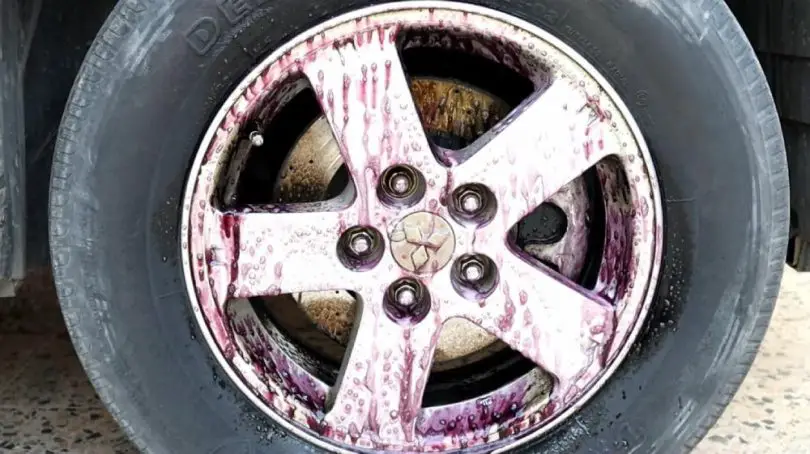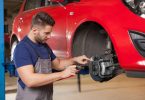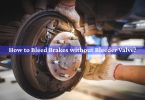When cleaning their car, most people overlook the wheels and brakes. Clean brakes work more efficiently. If there is one part of the car you want in good working order, it is the brake system.
Here we will look at brake cleaners, why they are important, how to use brake cleaners without removing the tire, and pro tips to get lasting results.
Why clean brakes are important
While clean brakes increase the wheel’s aesthetic, they are essential for the safety of the vehicle’s passengers.
Over time grease, dirt, and dust build-up on the brakes and affect how they work. Cleaning the brakes periodically increases their efficiency and will make the brakes last longer.
Choosing a Brake Cleaner
Brake cleaner comes in two forms, non-chlorinated and chlorinated. Their difference is in the chemicals used in their production.
1. Non-chlorinated brake cleaner
Of the two cleaners, the non-chlorinated brake cleaner is the most eco-friendly. Its contents include chemicals such as low-toxicity petroleum hydrocarbons, heptane, isopropyl alcohol, and acetone.
These ingredients make non-chlorinated brake cleaners extremely flammable, require a longer drying time, and have poorer solvency than chlorinated cleaners, but they clean just as well.
2. Chlorinated brake cleaner
Chlorinated brake cleaners have Volatile Organic Compounds (VOC), including Methyl Chloride, Perchloroethylene, and Trichloroethylene. The toxic fumes from chlorinated brake cleaner are so harmful to animals and humans that California has banned its use!
When using brake cleaner in spray (aerosol) form, safety goggles, masks, and gloves should be worn, and the area should be well ventilated.
3. WD-40
While many recommend WD-40 for brake cleaning, it is NOT brake cleaner and will ruin
your brake pads. Brakes use friction when stopping the vehicle. The oil in WD-40 eliminates this friction. If you use WD-40 on the brakes, you will need to replace the brake pads to ensure the brakes function properly.
4. Soap and water
Soap and water will not harm the brakes, but it doesn’t remove the greasy debris that may be on them. Soap and water are fine when cleaning the car at the car wash, but if you want the brakes cleaned correctly, brake cleaner is the best choice.
Using a Brake Cleaner Without Removing the Tire
Using the brake cleaner with the tires on can be done in two ways, a quick and easy way and a more thorough cleaning with the car on a jack.
1. Cleaning on a flat surface
Tools
- Brake cleaner
- Soft dry cloth
- Air compressor, blower, or vacuum
- Brush
- Wet cloth
- Safety goggles and mask
- Gloves – optional
Step 1: On a flat surface, park the vehicle in a well-ventilated area. Read the package directions for the brake cleaner before starting.
Step 2: Use the compressor, blower, or vacuum to remove any loose dirt and debris from the tire, brake pads, calipers, and rotors.
Step 3: Spray the brake cleaner onto the wheel and brakes. Get as little as possible on the rubber part of the wheel. Do not soak the parts. Just enough cleaner to get them their cleanest. If the cleaner came with a straw, use it to get in tight or deep places you cannot reach. Do not get it on the paint. It will remove the finish.
Step 4: While you wait for the brake cleaner to do its magic, wipe any brake cleaner off the tire with a damp cloth. Use the brush to remove stubborn grime. Wipe any extra cleaner off the rim with a soft cloth while the brake parts dry.
Step 5: Once the brake pads, rotor and calipers are dry, your work is done.
2. Cleaning with the car on a jack
Jacking the car lets, you get to places you can’t with the car on the ground to ensure a more thorough cleaning.
Tools
- Brake cleaner
- Soft dry cloth
- Air compressor, vacuum, or blower
- Brush
- Wet cloth
- Car jack
- Safety goggles and mask
- Gloves – optional
Step 1: Parking the car on a flat surface will help stabilize the vehicle. Make sure the area has good ventilation. Use the jack to jack up the car on the dirty wheel’s side. Read the brake cleaner directions before starting.
Step 2: Use the air compressor, vacuum, or blower to remove the dirt and debris from the tire and the brake components.
Step 3: Using the brake cleaner with the straw attachment, spray the brake components and the metal parts of the wheel. Use enough cleaner to do the job thoroughly but don’t soak the pieces. Be careful not to get the brake cleaner on the paint or rubber parts on the tire.
Step 4: Remove any brake cleaner from the tire rubber with a damp cloth. Then use the brush to remove stubborn grime and grease.
Step 5: While the brake cleaner dries, wipe the excess cleaner off the wheel’s rim. Let the cleaner on the calipers, brake pads, and rotor dry.
Step 6: Once all the brake parts are dry, jack the car down, and you are finished.
How often should brakes be cleaned?
Any time you see the brakes are dirty, you can do the easy cleaning above. It doesn’t take long for brakes to get dirty, especially in wooded areas or in wet and snowy conditions. It never hurts to clean the parts of the brake you can see.
A brake specialist recommends deep cleaning the brake system by removing the tires at least once a year. Living in a place with lots of dust or mud, you may want to clean them twice a year.
Tips for using brake cleaner
- Use a stiff toothbrush to remove as much dirt as possible before spraying the cleaner
- Using a precision straw will help you get to those deep areas
- Do not let the brake cleaner touch your paint
- Only use brake cleaners in a well-ventilated area
- Wear gloves, safety goggles, and masks when using brake cleaner
- Remove brake cleaner from tire rubber as soon as possible to avoid damage to the rubber’s protective coating










Leave a Comment